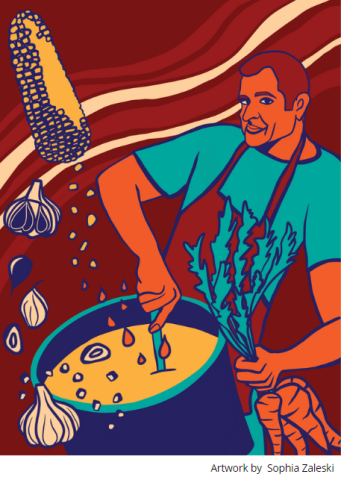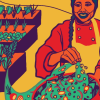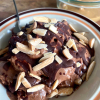Riz was a fundamental part of the kitchen crew before joining Food Shift as their Office Manager. He is a curious cook and often shares his culinary creations with his friends and colleagues. In this recipe, Riz uses all of his ingredients to their full potential, turning veggie scraps and corn kernels as well as cobs into a flavorful no-waste chowder.
“Having been a volunteer in the Food Shift Kitchen for several years, I’ve absorbed a lot of the formal culinary instruction by osmosis, prepping vegetables side-by-side with our apprentices and chefs. That’s how I first learned how to dice carrots and many other vegetable-slicing techniques. I’ve picked up solid knife and life skills in the process!
Chef Jen’s practical “Getting Scrappy” video has inspired me to regularly freeze veggie scraps. It’s great to make flavorful broth. Once cooled, I freeze portions flat in zip top bags so they’re easy to stack, and I always have fresh broth on hand. I then experimented with freezing corn cobs, with most of the kernels already removed (by eating). These frozen cobs became the base for a savory broth simmered together for an hour. After straining, the key to really getting all the corny goodness out of the cobs is to squeeze and twist all the juice and flavor out of them (they can then go into the compost). This aromatic, savory broth became the base for my corn chowder, which turned out pretty awesome. I create most of my recipes by combining different internet versions of whatever I’m making. I live alone, so I often share half of a big batch with a friend, served up in a recycled to-go container.”
Corn Chowder Recipe
Corn shines as the main ingredient in this recipe. You can keep it simple and enjoy the corn's sweetness as the prominent flavor, or jazz up your chowder with any of the optional add-ins.
Corn Broth
Yield: 6–8 cups
INGREDIENTS:
- 3 corn cobs cut in half, kernels removed and set aside for chowder*
- 2 quarts (8 cups) water
- 1 tsp salt
Optional ingredients that Riz likes to add to his broth: - 1 onion, quartered (leave the skin on) or the green part of a leek
- A few garlic cloves, smashed (leave the skin on)
- ½ tsp whole peppercorns
- 1 tsp coriander seeds
- 1–2 bay leaves
INSTRUCTIONS:
-
Combine all the ingredients (except the corn kernels) in a stock pot.
-
Bring to a boil and reduce to a simmer. Loosely cover with a lid and let cook for 1 hour.
-
Strain into a large container. Let corn cobs cool slightly until they are okay to touch and squeeze and twist all of the flavorful juices into the broth.
-
*To shuck corn: grab the tops of the husks (leaves), opposite from the stem, and pull from top to bottom, peeling away all of the silk and husks. Compost the silk and the husks. To remove corn kernels from corn cobs, break the cob in half and place the flat cut side on the cutting board before cutting off the kernels, in four to six vertical slices.
-
This broth is now ready to use with the corn chowder recipe that follows or, once cooled, store it in containers in the fridge or freezer for later use.
Corn Chowder
Serves 4–6
INGREDIENTS:
- 2 Tbsp oil
- 1 onion (any color), peeled and diced; or 1 Tbsp onion powder
- Corn kernels from 3 corn cobs; or 3 cups of frozen corn, thawed
- 2 garlic cloves, peeled and minced; or ¼ tsp garlic powder
- Optional spices: 1 tsp Italian seasoning, ½ tsp paprika, and/or a pinch cayenne pepper
- 2 Tbsp flour
- 1 lb potatoes, cut into bite sized cubes (about 3 cups)
- 1½ quarts (6 cups) corn broth (add more as needed)
- 1 cup milk, or dairy free milk, or 3 Tbsp of sour cream
- Salt and black pepper to taste
- Optional garnishes: thinly sliced green onions, small handful of finely chopped parsley, leftover bacon bits, mushroom bacon (from our previous blog post)
INSTRUCTIONS:
- Heat a medium stock pot over medium heat. Once warm, add 2 Tbsp oil to the pot.
- Add onion, corn kernels, and garlic with a pinch of salt and sauté over medium heat until onions are translucent and starting to turn golden, about 7 minutes. Optional spices can be added in now and sauteed for another few minutes.
- Add flour and stir constantly for 1 minute.
- Slowly add the corn broth, stirring constantly. Bring to a simmer.
- Add potatoes and bring back to a simmer. Continue cooking for about 20 minutes, uncovered and stirring occasionally, until the potatoes are tender.
- Stir in milk or sour cream and a pinch of black pepper.
- Taste and season as you see fit.
- Ladle into bowls. Add sliced green onions, parsley and bacon as a garnish, if using.
Notes: As a variation, use a potato masher or fork to slightly mash the chowder to thicken the soup. Or try using a blender to make a creamy version of the soup.
Maximizing Your Food
Corn cobs are often thrown in the compost, but this recipe uses whole ears of corn minus the husks. The cobs have the same sweet flavor as the kernels and shouldn’t be wasted. The cobs can also be frozen if you don’t have time to make a broth when you have corn on the cob or need just the corn kernels. If you’d like to freeze your corn for later use, remove the kernels from the cob and freeze them separately.
For additional flavor, you can use the broth in any savory recipe, such as a base of a soup to cook grains like rice or grits. Substitute equal parts of the corn broth for the water.
More stories, recipes, tips, and videos from Food Shift:
- Ms. Debra's Potato Salad
- Kim's Bean Burgers
- Connie's Breakfast Frittata
- Danny’s Mushroom "Bacon"
- Lia's Fried Rice
- Food Shift Kitchen Guide
- Affordable Alternatives
Food is often rooted in story. In this monthly blog series, Food Shift, one of our Chef Partners, is amplifying the voices of their culinary training graduates and their community by sharing their stories and adaptable recipes. Stay tuned for more installments.
Portrait Artwork By: Sophia Zaleski
Learn more about Food Shift and their programs to rescue surplus food to fuel their social enterprise kitchen rather than waste away in landfills.












